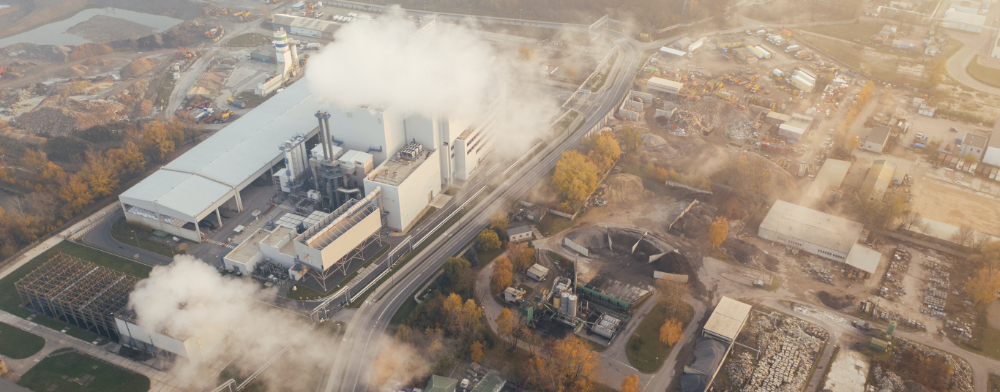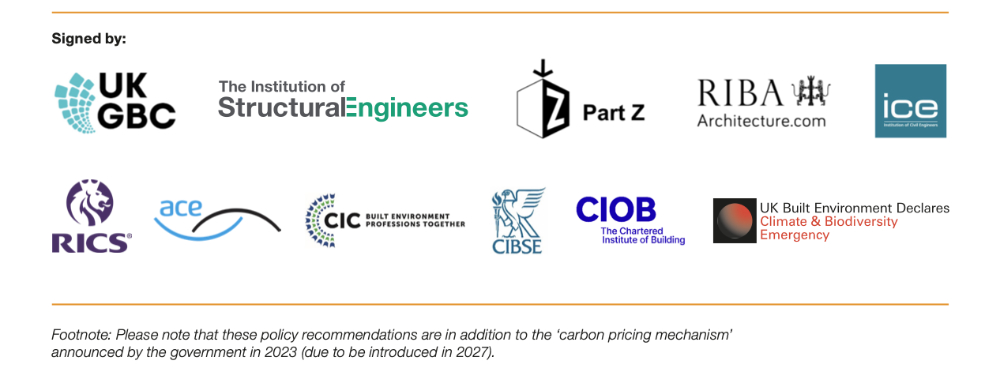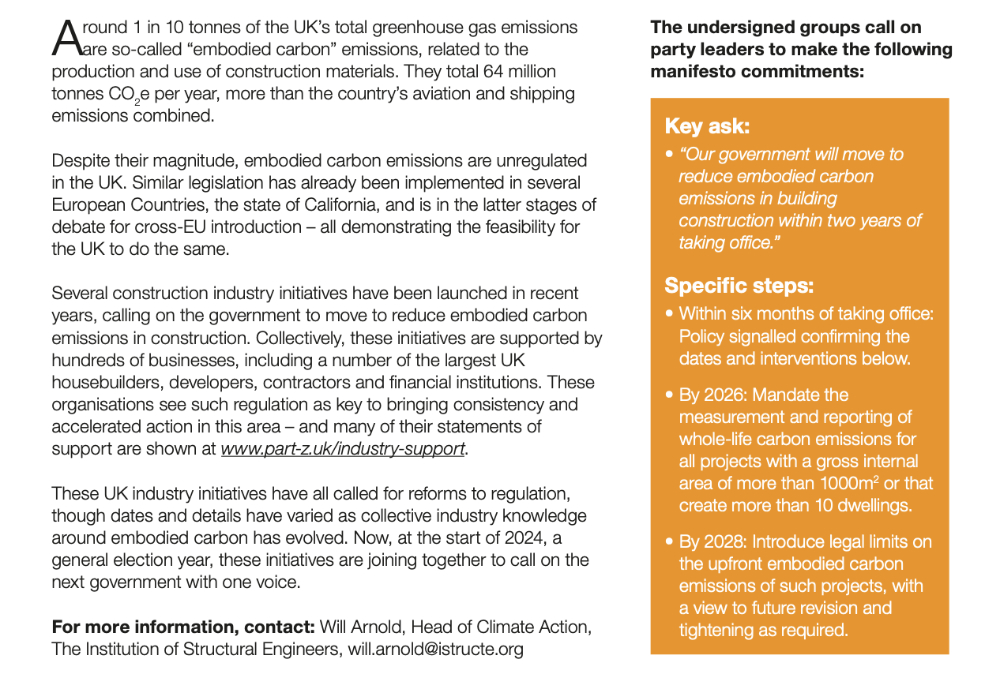CIOB joins forces to urge Government to regulate embodied carbon
CIOB has joined leading organisations to warn political leaders about the urgent need for regulation of embodied carbon emissions in construction.
The Chartered Institute of Building (CIOB) has teamed up with 10 leading organisations to warn political leaders about the urgent need for regulation of embodied carbon emissions in construction.
Environment experts from CIOB, UK Green Building Council, The Institution of Structural Engineers, the Institution of Civil Engineers, Construction Industry Council, Chartered Institution of Building Services Engineers, UK Architects Declare, RIBA, RICS, Association for Consultancy and Engineering and Part Z have all joined forces to send a clear message to Government.
They warn regulation is necessary because buildings and construction form a substantial part of UK carbon emissions, which are a main driver of climate change. The group believes UK policy has stalled and urgent action is needed.
Amanda Williams, Head of Environmental Sustainability at CIOB, said: “There have been numerous industry initiatives over recent years, calling for government action to reduce the construction industry’s embodied carbon emissions.
“We now join forces as an expert group to pull these proposals together, uniting with one voice for change and asking Government to ensure the UK keeps pace with those who are currently leading this agenda.”
The group of experts has issued a paper to political leaders with a key ask: to include in their manifestoes a commitment to move to reduce embodied carbon emissions in construction within two years of starting government.
Steps for action include:
- In 2024: Policy signalled to confirm the dates and interventions below.
- By 2026: Mandate the measurement and reporting of whole-life carbon emissions for all projects with a gross internal area of more than 1000m2 or that create more than 10 dwellings.
- By 2028: Introduce legal limits on the upfront embodied carbon emissions [those emissions due to the use of materials in the initial construction] of such projects, with a view to future revision and tightening as required.
The group says these actions are essential as around one in 10 tonnes of the UK’s total greenhouse gas emissions are “embodied carbon” emissions. These relate to the production and use of construction materials, which account for a substantial part of the UK’s overall carbon emissions.
Policy recommendations would be complementary to the ‘carbon pricing mechanism’ announced by the government in 2023 and which is due to be introduced in 2027, as well as to existing UK initiatives that incentivise the use of lower carbon cement and steel.
This article appears on the CIOB news and blog site as "CIOB joins forces to urge Government to regulate embodied carbon" dated January 31, 2024.
--CIOB
[edit] Related articles on Designing Buildings
- An in-depth look at Environmental Product Declarations EPDs.
- BPIE report urges EU to incorporate the carbon footprint of construction into policy.
- BS EN 15978-1.
- BSRIA Whitepaper on Embodied Carbon NZG 4/2023
- Carbon dioxide.
- Carbon footprint.
- Climate change act.
- Climate change science.
- Climate Emergency Design Guide.
- Cradle to grave.
- Dr. Natasha Watson; UK lead for embodied carbon at Buro Happold.
- Embedded carbon emissions.
- Embodied carbon.
- Embodied energy.
- EN 15804+A1 2012.
- Environmental product declaration EPD.
- Greenhouse gas.
- Life Cycle Carbon Emissions.
- Mandatory and optional environmental impact categories.
- Optional environmental impact categories.
- PHribbon tool calculates embodied carbon of designs.
- Product Environmental Footprint PEF.
- Product category rules PCR.
- RICS launches new global edition of its ground-breaking Whole Life Carbon Assessment standard.
- Sustainable procurement.
- Sustainability in building design and construction.
- The sustainability of construction works.
- Upfront emissions.
- Use stage embodied carbon.
- Wood, embodied carbon and operational carbon.
- Whole life carbon.
Featured articles and news
Delivering for tenants; National Retrofit Hub
New report offers recommendations to strengthen energy efficiency standards to protect private renters.
Government consultations for the summer of 2025
A year of Labour, past and present consultations on the environment, the built environment, training and tax.
CMA competitiveness probe of major housing developers
100 million affordable housing contributions committed with further consultation published.
Homes England supports Greencore Homes
42 new build affordable sustainable homes in Oxfordshire.
Zero carbon social housing: unlocking brownfield potential
Seven ZEDpod strategies for brownfield housing success.
CIOB report; a blueprint for SDGs and the built environment
Pairing the Sustainable Development Goals with projects.
Types, tests, standards and fires relating to external cladding
Brief descriptions with an extensive list of fires for review.
Latest Build UK Building Safety Regime explainer published
Key elements in one short, now updated document.
UKGBC launch the UK Climate Resilience Roadmap
First guidance of its kind on direct climate impacts for the built environment and how it can adapt.
CLC Health, Safety and Wellbeing Strategy 2025
Launched by the Minister for Industry to look at fatalities on site, improving mental health and other issues.
One of the most impressive Victorian architects. Book review.
Common Assessment Standard now with building safety
New CAS update now includes mandatory building safety questions.
RTPI leader to become new CIOB Chief Executive Officer
Dr Victoria Hills MRTPI, FICE to take over after Caroline Gumble’s departure.
Social and affordable housing, a long term plan for delivery
The “Delivering a Decade of Renewal for Social and Affordable Housing” strategy sets out future path.
A change to adoptive architecture
Effects of global weather warming on architectural detailing, material choice and human interaction.
The proposed publicly owned and backed subsidiary of Homes England, to facilitate new homes.
How big is the problem and what can we do to mitigate the effects?
Overheating guidance and tools for building designers
A number of cool guides to help with the heat.
The UK's Modern Industrial Strategy: A 10 year plan
Previous consultation criticism, current key elements and general support with some persisting reservations.
Building Safety Regulator reforms
New roles, new staff and a new fast track service pave the way for a single construction regulator.






























